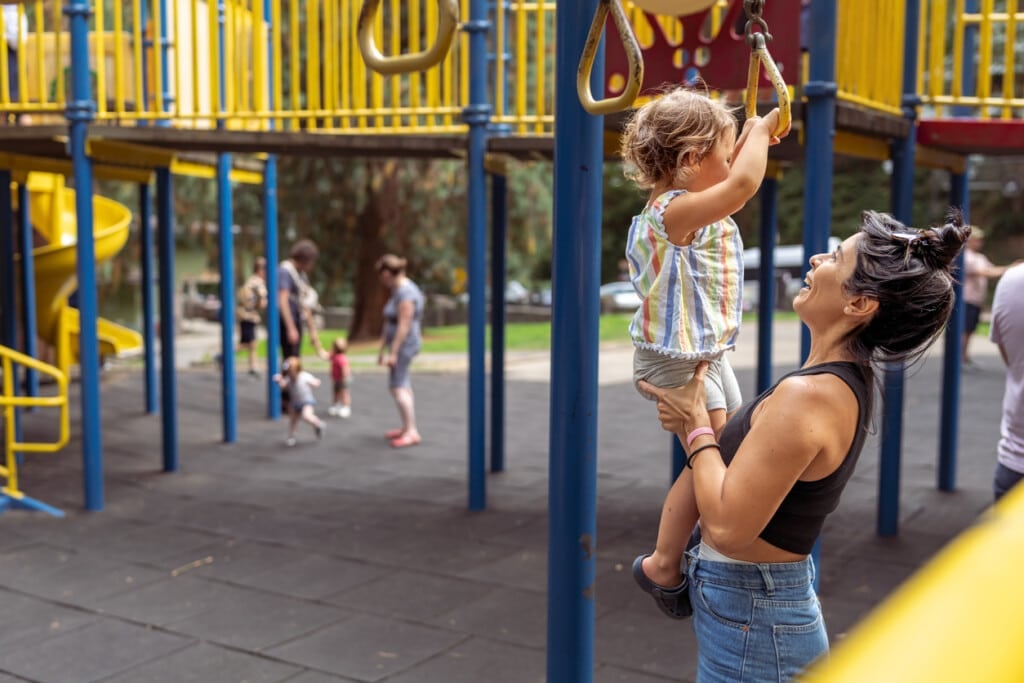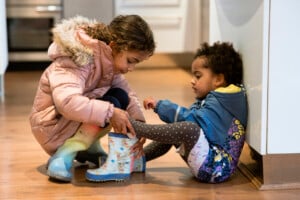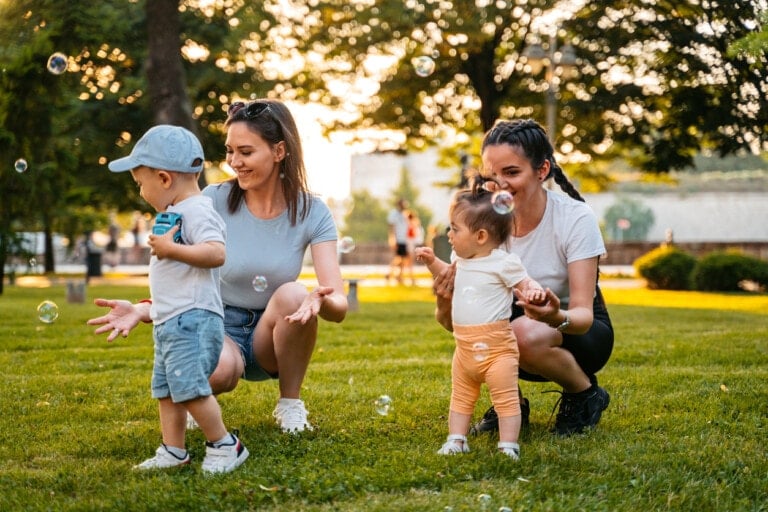A few hours at the playground can be an excellent way to spend your day. But for some families, playground politics, shy kids, and unwanted behaviors can turn a good time into an unpleasant memory. We talked to some pros to get tips on everything from helping your child understand the other side of playground arguments to ensuring your big kiddo doesn’t accidentally trample smaller friends. Hence, your next family outing to the playground feels like a true walk in the park.
What To Do if Your Child is Shy at the Playground
According to children’s therapist Erica Miller, playgrounds can be overwhelming and overstimulating for many children. “We, adults, often interpret shyness as a sign of weakness, something that may hold them back in life,” she explains. “We tend to say, ‘Go on, go play. All your friends are over there.’ But the flip side is that this is a child who knows when they are or when they are not comfortable with something and are able to advocate for themselves.”
Instead of pushing their child into joining in on an activity they may not be ready for or interacting with children they find intimidating, Miller says parents should tell their children that they trust them to know when they are ready to play.
As parents, we know it can be hard to watch your child struggle, especially when it comes to something as fun as a playground. Miller says parents of shy kiddos should prepare some alternatives for group play at the park. “It can also be helpful to bring a toy or a book or something for them to do on their own.”
What To Do if Your Child is Bossy at the Playground
You likely already know if you have a bossy kiddo at home, which is something family therapist and life coach Daniel Rinaldi says can give you a leg up when helping your child navigate playground politics. He suggests prepping your child beforehand by having meaningful and age-appropriate conversations about sharing and collaboration before you head out the door.
“Use terms that are child-friendly, such as, ‘Sharing is like taking turns. Just like you take turns with your toys or games at home, we take turns with the playground equipment so everyone gets a chance to have fun,'” he says.
Nobody wants their kid to be on the wrong side of a playground argument, especially when it can be avoided with some practice. “If your child tends to boss other children around, it’s a great opportunity to teach them that everyone is in control of their own body and makes decisions for themselves,” Rinaldi said.
Rinaldi says he likes role-playing in these cases and models what sharing looks like in an understandable way based on a child’s life experience, like doing a few exercises where you take turns with toys or games at home.
“When you head to the playground, it’s a great chance to teach them about building community, ‘This is a fun place for everyone to play, and we can take turns playing together,’ and make sure to offer positive reinforcement when they share with others,” he said.
However, this process is a work in progress, and Rinaldi warns against expecting results too quickly. “As we’re working with children, this can take some time to learn, so remember to keep an eye on your child, and gently intervene and guide them if they need a little redirection.”
What To Do if Your Child is Unsure What To Do at the Playground
Miller says when children are unsure of what to do, they may benefit from narrating or modeling, which means you may have to get your hands (and knees) a little dirty to help children who aren’t sure where to begin.
“These kids often benefit from watching their parents or other kids use the playground or even practice one or two things at once,” she says. “As they build physical mastery and confidence, they may be more ready to try out new things.”
If you would rather be a passive participant in their playground experience, Miller says you can always talk them through the process by explaining what other children are doing. “Narrating may be in the form of, ‘Oh, see that boy over there. Look how he is climbing the stairs, putting one front in front of the other and holding onto the railing.'”
What To Do if Your Child is Aggressive at the Playground
Aggressive behavior can sometimes be a sign that something else is amiss, according to Rinaldi, who says these types of kids could be acting out because they’re feeling anxious or like they aren’t in control of a situation.
“Maybe they are nervous to play with new children, or maybe they are frustrated that they can’t keep up with children. There are many reasons that children can become aggressive on the playground, but no matter what the reason, first and foremost, you have to keep a watchful eye and stay close to your child if they’re displaying aggressive behavior,” he cautions.
Start Correcting Behavior at Home
As with most teachable moments, correcting this behavior should begin at home. Rinaldi says parents and caregivers should discuss what it feels like to become aggressive in their body, how their body shows aggression, and how it can affect others. “Coming up with strategies to calm their body down (like removing yourself from the situation, taking a few breaths, having some water) is a conversation you’d want to have at home and have often to remind them that they have tools to feel more calm and less aggressive,” Rinaldi said.
He added that this is incredibly important because the playground is a place to reinforce and model the coping mechanisms they already know, not somewhere you want to begin teaching them new ways to cope, especially if they’ve already found themselves on the other side of a playground argument.
“If your child becomes aggressive at the playground, you need to guide them to a safe space and enlist the calming tools you’ve been working on together, and when they’re ready to play again, remind them that you are close by if they need to take a moment to feel calm in their body again,” he says.
What To Do if Your Child Isn’t the Same Size as Other Kids
Adults know that everyone comes in different shapes and sizes, but children may have a more challenging time dealing with that concept, especially if they’re bigger or smaller than the other children they’re playing with.
It can be helpful to remind kids who are big for their age that they may need to be a bit more gentle when playing with others, especially when engaging in full-contact play — for example, reminding them to tag smaller children gently while chasing one another around.
If you’re dealing with a smaller child, try encouraging them to steer away from rougher play or activities where their size could get them hurt.
Strategies for Teaching Collaborative Play
When they are little, children play in a parallel fashion — near or next to other children but not with them. However, as they begin navigating the playground, they move into a different stage of play called collaborative play (playing with other children, not just alongside them). Supporting them to develop the skills to engage in collaborative play helps them identify and practice social skills where they learn to work with others and understand that they aren’t the only person in the world.1
Tips to Encourage Collaborative Play
Here are several tips to help encourage your little one to try collaborative play:
- Turn-taking: Practice turn-taking at home and start small. This could be taking turns to pour each other a cup of imaginary tea or bouncing a ball back and forth between you both. You might even progress to using a timer and push them a little further. For example, saying, “You can play for one minute, and then it’s my turn for one minute. Let’s set the timer so you can see how long you need to wait.” This teaches them to delay gratification, which they need when waiting for a toy or activity at the playground.2
- Setting boundaries: It’s important to have clear expectations and consequences before you go to the playground. Set your child up for success by laying out the ground rules before you get there, not once challenging behaviors appear.
- Teaching negotiation skills: To navigate playground arguments (regardless of which side they are on), our kids need to learn how to navigate squabbles. You can model these skills at home, which is the most effective way of teaching our little people to negotiate.3 For instance, you might say, “You really want the ball I’m playing with; you can have it if I can take a turn of the doll you are playing with,” or “You want to play for five more minutes? How about you brush your teeth quickly first, and then I’ll let you play for five more minutes?”
The playground is meant to be a fun experience for children and their caregivers. Sometimes, a little prep work and a whole lot of encouragement are all you’ll need to ensure everyone has a good time.

































